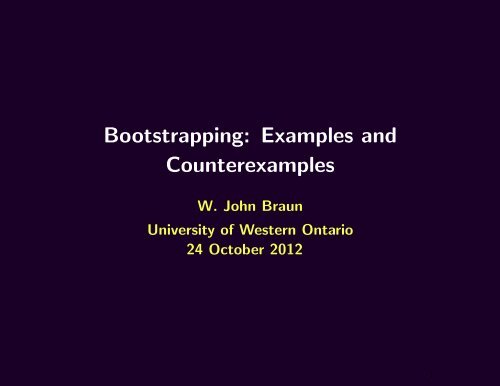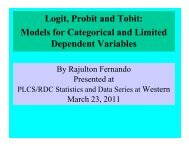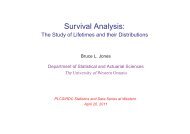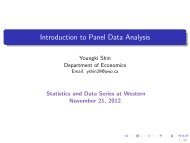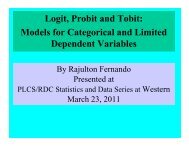Bootstrapping Examples and Counterexamples
Bootstrapping - University of Western Ontario
Bootstrapping - University of Western Ontario
- No tags were found...
Create successful ePaper yourself
Turn your PDF publications into a flip-book with our unique Google optimized e-Paper software.
<strong>Bootstrapping</strong>: <strong>Examples</strong> <strong>and</strong><br />
<strong>Counterexamples</strong><br />
W. John Braun<br />
University of Western Ontario<br />
24 October 2012<br />
1
Outline<br />
1. Introduction<br />
2. Confidence Intervals<br />
3. Implementation in R with the boot() Library<br />
4. Bootstrap Failure<br />
2
Introduction<br />
The usual statistical problem:<br />
Population<br />
θ<br />
Sample<br />
θ^<br />
Estimate the population parameter θ using the sample<br />
estimate ̂θ.<br />
3
Introduction<br />
Fact: θ ≠ ̂θ<br />
Question: How wrong is the estimate?<br />
Statistical Answer: assess variability of ̂θ<br />
st<strong>and</strong>ard errors, confidence intervals, p-values for<br />
hypothesis tests about θ<br />
4
Introduction<br />
In an ideal world:<br />
Sample<br />
θ^<br />
Sample<br />
θ^<br />
Sample<br />
θ^<br />
Sample<br />
θ^<br />
Population<br />
θ<br />
Sample<br />
θ^<br />
Sample<br />
θ^<br />
Sample<br />
θ^<br />
Assess variability of the sample estimate ̂θ by taking<br />
additional samples, obtaining new estimates of θ each time.<br />
5
Introduction<br />
Statistical theory, based on independence <strong>and</strong> normality<br />
assumptions, for example, has allowed us to obtain<br />
formulas for variances, st<strong>and</strong>ard errors, confidence intervals<br />
<strong>and</strong> p-values for a large number of statistics.<br />
e.g. recall: st<strong>and</strong>ard error of the sample mean, ¯X: σ/ √ n<br />
Problem! What if our assumptions are not quite right? Or,<br />
what if we can’t obtain a useful formula?<br />
6
Introduction: Example<br />
What is the st<strong>and</strong>ard error of the trimmed mean?<br />
7
Introduction: St<strong>and</strong>ard error of the trimmed mean<br />
Consider the sample<br />
78 86 92 81 3 89 94 88 79 85<br />
The α trimmed mean is the average of the inner (1 − 2α)<br />
values in the sample.<br />
For example, if α = .2, then the trimmed mean is the<br />
average of the inner 60% of the observations.<br />
8
Introduction: St<strong>and</strong>ard error of the trimmed mean<br />
We can compute the α = .2 trimmed mean in R for the<br />
above sample with the following code:<br />
> x x.tmean x.tmean<br />
[1] 84.66667<br />
This is the average of the 6 innermost observations, i.e.<br />
excluding 3, 78, 92 <strong>and</strong> 94.<br />
Note: untrimmed mean is 77.5, due to outlier.<br />
9
Introduction: St<strong>and</strong>ard error of the trimmed mean<br />
It is always good practice to supply a st<strong>and</strong>ard error<br />
estimate.<br />
For the trimmed mean, this is not straightforward.<br />
Recall that the st<strong>and</strong>ard error is the st<strong>and</strong>ard deviation of<br />
the estimator based on the underlying distribution of the<br />
data.<br />
10
Introduction: Parametric Bootstrap<br />
For definiteness, let’s suppose that the data have really<br />
come from a normal distribution. (The outlier is thus<br />
assumed anomalous.)<br />
Estimated mean: 84.7. (trimmed mean)<br />
Estimated st<strong>and</strong>ard deviation: 6.86. (IQR/1.349)<br />
i.e.<br />
> diff(quantile(x, c(.25, .75)))/1.349<br />
75%<br />
6.856931<br />
11
Introduction: Parametric bootstrap<br />
We can simulate from this fitted distribution repeatedly,<br />
computing the trimmed mean in each case.<br />
The collection of trimmed means is then used to estimate<br />
the st<strong>and</strong>ard deviation of the trimmed mean for such a<br />
population.<br />
This technique pre-dates the bootstrap: Monte Carlo<br />
simulation with a new name.<br />
12
Introduction: Parametric bootstrap<br />
One such simulated sample <strong>and</strong> estimate is obtained as<br />
follows:<br />
> set.seed(1038087) # this allows you to obtain<br />
> # the same numerical values below.<br />
> x1 x1trim x1trim<br />
[1] 82.46431<br />
13
Introduction: Parametric bootstrap<br />
We generate 10000 samples <strong>and</strong> the respective trimmed<br />
mean estimates. Then we calculate the st<strong>and</strong>ard deviation<br />
of the whole collection as follows:<br />
> x10000 sd(x10000)<br />
[1] 2.285725<br />
Note: that the st<strong>and</strong>ard error of the ordinary sample mean<br />
in this case is s/ √ n = 6.86/ √ 10 = 2.17.<br />
14
Introduction: St<strong>and</strong>ard error of the trimmed mean<br />
We often do not know the true underlying distribution.<br />
We cannot simulate from a parametric distribution.<br />
However, we can use the sample itself as an estimate of<br />
the true underlying population.<br />
In other words, by viewing the sample as a population, <strong>and</strong><br />
simulating from that, we can assess variability of an<br />
estimate.<br />
15
Introduction: Subsampling<br />
In the real world:<br />
Subsample<br />
θ^^<br />
Subsample<br />
θ^^<br />
Subsample<br />
θ^^<br />
Subsample<br />
θ^^<br />
Sample<br />
θ^<br />
Subsample<br />
θ^^<br />
Subsample<br />
θ^^<br />
Subsample<br />
θ^^<br />
Assess variability of ̂θ by estimating θ for each subsample<br />
(where sample size is m < n).<br />
16
Introduction: Subsampling<br />
Subsample from the original sample (using m = 5):<br />
> indices x.sub1 x.sub2 x.sub1<br />
[1] 85 3 94 92 89<br />
> x.sub2<br />
[1] 78 86 81 88 79<br />
17
Introduction: Subsampling<br />
Compute the trimmed mean for these subsamples:<br />
> mean(x.sub1, trim=.2)<br />
[1] 88.66667<br />
> mean(x.sub2, trim=.2)<br />
[1] 82<br />
18
Introduction: Subsampling<br />
Estimate the st<strong>and</strong>ard error by taking the st<strong>and</strong>ard<br />
deviation of the sample means:<br />
> sd(c(mean(x.sub1), mean(x.sub2)))<br />
[1] 6.929646<br />
19
Introduction: Subsampling<br />
... provides good assessments of variability in ̂θ<br />
... but assumes a sample size of m<br />
Adjust if you can. E.g.,<br />
> sd(c(mean(x.sub1), mean(x.sub2)))*sqrt(5/10)<br />
[1] 4.9<br />
Subsampling is often available as a reliable (if inefficient)<br />
backup for the nonparametric bootstrap.<br />
20
Introduction: Nonparametric bootstrap<br />
In the bootstrap world:<br />
Re−sample<br />
θ^^<br />
Re−sample<br />
θ^^<br />
Re−sample<br />
θ^^<br />
Sample<br />
θ^<br />
Re−sample<br />
θ^^<br />
Re−sample<br />
θ^^<br />
Re−sample<br />
θ^^<br />
Re−sample<br />
θ^^<br />
Assess variability of the sample estimate ̂θ by taking<br />
re-samples, obtaining new estimates of θ each time.<br />
21
Introduction: Nonparametric bootstrap<br />
Re-sample from the original sample with replacement:<br />
> x.nonparbs1 x.nonparbs1<br />
[1] 79 94 89 85 79 86 89 86 92 94<br />
Compute the trimmed mean for this resample:<br />
> mean(x.nonparbs1, trim=.2)<br />
[1] 87.83333<br />
22
Introduction: Nonparametric bootstrap<br />
Repeat the calculation a large number of times:<br />
> x.nonparbs10000 sd(x.nonparbs10000)<br />
[1] 5.419144<br />
23
Introduction: Nonparametric bootstrap<br />
Problem! The outlier can appear several times in a<br />
resample, allowing it to enter the calculation of the<br />
estimate inflation of the st<strong>and</strong>ard error estimate.<br />
e.g. st<strong>and</strong>ard error of sample mean:<br />
> xbar10000 sd(xbar10000) # compare with 2.17<br />
[1] 8.127203<br />
24
Confidence Intervals: Normal type<br />
1. Estimate the st<strong>and</strong>ard error of ̂θ using the<br />
nonparametric bootstrap: ŝ<br />
2. Interval endpoints: ̂θ ± ŝz α/2<br />
where z α is the α upper percentile of the st<strong>and</strong>ard normal<br />
distribution.<br />
This technique obviously requires that the distribution of ̂θ<br />
be well approximated by normality (which is often not<br />
true).<br />
25
Basic Confidence Intervals<br />
To estimate θ with a symmetric (1 − 2α) confidence<br />
interval centered at ̂θ, we need to find t in<br />
P ( ̂θ − t ≤ θ ≤ ̂θ + t| population) = 1 − 2α.<br />
Bootstrap principle: approximate the above equation with<br />
P (̂̂θ − t ≤ ̂θ ≤ ̂̂θ + t| sample) = 1 − 2α. (1)<br />
The solution, ̂t: (1 − 2α) percentile of | ̂θ − ̂̂θ|.<br />
Basic confidence interval:<br />
̂θ ± ̂t.<br />
26
Studentized Confidence Intervals<br />
These confidence intervals are require an estimate of the<br />
st<strong>and</strong>ard deviation of ̂θ.<br />
̂θ ± ŝ̂t<br />
where ̂t is the 1 − 2α percentile of the distribution of<br />
|̂̂θ − ̂θ| .<br />
ŝ<br />
27
Studentized Confidence Intervals<br />
The st<strong>and</strong>ard deviation estimate ŝ need not be consistent.<br />
When regularity conditions are satisfied by the data, these<br />
intervals can be much more accurate than the basic<br />
intervals. (Unfortunately, conditions are not nearly always<br />
satisfied.)<br />
28
Percentile Confidence Intervals<br />
α <strong>and</strong> 1 − α percentiles of the distribution of ̂̂θ.<br />
Originally proposed by Efron (1979)<br />
Efron (1987) discovered a way of improving confidence<br />
interval accuracy using what he called accelerated bias<br />
correction (BCa).<br />
BCa intervals are often more accurate than percentile<br />
intervals, but can be unstable.<br />
29
Implementation using the boot() library<br />
(Canty, 2002)<br />
The following data which were collected during an escape<br />
drill on an oil platform: times (in seconds) for a sample of<br />
individuals to escape.<br />
> escape
Implementation<br />
How much warning time is necessary to be almost certain<br />
that everyone could escape during an emergency?<br />
A possible measure: θ = µ + 4σ,<br />
where µ <strong>and</strong> σ are the escape time mean <strong>and</strong> st<strong>and</strong>ard<br />
deviation. We can estimate θ with ̂θ = ¯X + 4s.<br />
In order to use higher order bootstrap confidence intervals,<br />
we need an estimate of the variance of ̂θ.<br />
31
Implementation<br />
In this case, we could do an exact calculation, but it is<br />
tedious. Use of an iterated bootstrap to estimate the<br />
variance is one alternative.<br />
Another alternative is to use a delta method. If the data<br />
are normally distributed, we can show that<br />
Var( ̂θ) . = σ2<br />
n + 8σ2<br />
n − 1 − σ 2<br />
(n − 1) 2.<br />
Estimate with:<br />
s 2 n + 8s2<br />
n − 1 − s 2<br />
(n − 1) 2. 32
Implementation<br />
R Function to compute sample statistic <strong>and</strong> variance<br />
estimate:<br />
> escape.fun
Implementation<br />
Perform resampling <strong>and</strong> calculation of the statistics for<br />
each resample using the boot() function:<br />
> library(boot)<br />
> escape.boot
Implementation<br />
Output:<br />
> escape.boot<br />
ORDINARY NONPARAMETRIC BOOTSTRAP<br />
Call:<br />
boot(data = escape, statistic = escape.fun, R = 999)<br />
Bootstrap Statistics :<br />
original bias std. error<br />
t1* 468.1267 -2.899631 13.78719<br />
t2* 211.7408 -8.183151 55.70149<br />
35
Implementation<br />
Observations:<br />
The bootstrap st<strong>and</strong>ard error of the statistic is roughly the<br />
square root of the variance estimate.<br />
The estimate of θ is biased. This is due, largely, to the fact<br />
that s is a biased estimator for σ.<br />
Confidence intervals can now be computed using the<br />
boot.ci() function.<br />
36
Implementation<br />
> boot.ci(escape.boot)<br />
BOOTSTRAP CONFIDENCE INTERVAL CALCULATIONS<br />
Based on 999 bootstrap replicates<br />
CALL :<br />
boot.ci(boot.out = escape.boot)<br />
Intervals :<br />
Level Normal Basic Studentized<br />
95% (444.0, 498.0 ) (445.0, 497.8 ) (449.2, 508.8 )<br />
Level Percentile BCa<br />
95% (438.4, 491.3 ) (444.0, 502.9 )<br />
Calculations <strong>and</strong> Intervals on Original Scale<br />
Some BCa intervals may be unstable<br />
37
A GLM example<br />
A sequence of trials were conducted using a detector.<br />
In each trial, a number of objects were to be detected.<br />
The observed number of detected objects were recorded<br />
for each trial.<br />
The quality of the detector can be assessed by computing<br />
the proportion detected:<br />
̂p = # Observed<br />
# Expected<br />
A normal approximation can be used to obtain the<br />
confidence interval. (Bootstrap not needed.)<br />
38
A GLM example<br />
The data:<br />
> detect head(detect)<br />
Observed Expected<br />
1 3 3<br />
2 1 1<br />
3 5 7<br />
4 12 14<br />
5 6 6<br />
6 23 23<br />
39
A GLM example<br />
Fitting the binomial model using glm() (this is overkill, but<br />
instructive)<br />
> detect.glm summary(detect.glm)$coef<br />
(Intercept) 2.320604<br />
Estimate Std. Error z value Pr(>|z|)<br />
0.1824228 12.72102 4.519306e-37<br />
40
A GLM example<br />
Problem! The sample of observed detections might be<br />
underdispersed relative to the binomial distribution.<br />
If so, we could use quasi-likelihood. But this does not have<br />
the same simple interpretation.<br />
41
What is value of the dispersion parameter?<br />
> detect.glm disp disp<br />
[1] 0.7093484<br />
This is less than 1, but is it significantly less? We can use<br />
the bootstrap to find out.<br />
42
<strong>Bootstrapping</strong> the dispersion parameter<br />
> disp.fn
<strong>Bootstrapping</strong> the dispersion parameter<br />
> boot.ci(disp.boot)<br />
BOOTSTRAP CONFIDENCE INTERVAL CALCULATIONS<br />
Based on 999 bootstrap replicates<br />
CALL :<br />
boot.ci(boot.out = disp.boot)<br />
Intervals :<br />
Level Normal Basic<br />
95% ( 0.4051, 1.0335 ) ( 0.3809, 0.9889 )<br />
Level Percentile BCa<br />
95% ( 0.4298, 1.0378 ) ( 0.4827, 1.2670 )<br />
Calculations <strong>and</strong> Intervals on Original Scale<br />
Some BCa intervals may be unstable<br />
44
But do we believe the confidence intervals?<br />
The confidence intervals do not all tell us the same thing.<br />
BCa is supposedly the most accurate ... usually. Is it in<br />
this case?<br />
Since it is telling us that the dispersion parameter is not<br />
significantly different from 1, let’s suppose the binomial<br />
model is true <strong>and</strong> do a parametric bootstrap to see how<br />
accurate the BCa interval for dispersion is.<br />
45
A model for the parametric bootstrap<br />
Binomial model parameters:<br />
> p n p; n<br />
[1] 0.9105199<br />
[1] 30<br />
A small bootstrap simulation study:<br />
Create 100 simulated binomial data sets, <strong>and</strong> construct 95% BCa<br />
confidence intervals for the dispersion parameter in each case.<br />
46
A small bootstrap simulation study<br />
> ncorrect
Conclusion of simulation study<br />
The BCa intervals appear to be reliable in this case.<br />
It seems okay to believe the original data are not<br />
underdispersed.<br />
48
Bootstrap failure<br />
We now give some examples where the bootstrap is invalid.<br />
In some cases, it is possible to remedy the problem. ∗<br />
∗ This discussion follows parts of Section 3.6 of Shao <strong>and</strong> Tu (1995).<br />
49
Nonsmooth functions of the sample mean<br />
The bootstrap is often consistent for smooth functions of<br />
the sample mean.<br />
The smoothness condition is necessary.<br />
E.g., consider the parameter θ = g(µ) = √ |µ|.<br />
The statistic is ̂θ = √ | ¯X|.<br />
50
Nonsmooth functions of the sample mean<br />
When µ = 0,<br />
Percentile confidence intervals for √ |µ| never contain 0.<br />
BCa confidence intervals cannot be computed.<br />
Studentized 95% confidence intervals cannot always be<br />
computed.<br />
When n = 100, 47% of the 95% basic intervals contain 0.<br />
51
Nonsmooth functions of the sample mean<br />
What is causing the problem?<br />
A nonsmooth function of the mean<br />
µ<br />
0.0 0.2 0.4 0.6 0.8 1.0<br />
−1.0 −0.5 0.0 0.5 1.0<br />
µ<br />
52
What is causing the problem? (Percentile Case)<br />
A nonsmooth function of the mean<br />
µ<br />
0.0 0.2 0.4 0.6 0.8 1.0<br />
X<br />
X are always positive<br />
−> percentile CI can't work<br />
−1.0 −0.5 0.0 0.5 1.0<br />
µ<br />
53
What is causing the problem? (Basic Case)<br />
Deviations between ¯X <strong>and</strong> µ are similar to deviations<br />
between ̂¯X <strong>and</strong> ¯X...<br />
A nonsmooth function of the mean<br />
µ<br />
0.0 0.2 0.4 0.6 0.8 1.0<br />
X − 0<br />
X − X<br />
−1.0 −0.5 0.0 X 0.5 X 1.0<br />
µ<br />
54
What is causing the problem? (Basic Case)<br />
... which implies that deviations between √ | ¯X| <strong>and</strong> √ |µ|<br />
√<br />
tend to be larger than deviations between ̂¯X <strong>and</strong> √ | ¯X|.<br />
A nonsmooth function of the mean<br />
µ<br />
0.0 0.2 0.4 0.6 0.8 1.0<br />
X − 0<br />
X −<br />
X<br />
−1.0 −0.5 0.0 X 0.5 X 1.0<br />
µ<br />
55
What is causing the problem? (Basic Case)<br />
√<br />
| ¯X| is not converging to 0 fast enough, compared with<br />
the speed at which<br />
√<br />
| ̂¯X| is converging to √ | ¯X|.<br />
Remedy: Increase sample size used to calculate √ | ¯X| to<br />
speed up convergence.<br />
Really?!!<br />
56
What is causing the problem? (Basic Case)<br />
Actual Remedy: Slow down convergence of<br />
reducing bootstrap sample size.<br />
√<br />
| ̂¯X| by<br />
i.e. Use subsampling.<br />
Percentage of correct basic CIs when m = 25: 71%<br />
Percentage correct when m = 15: 85%.<br />
Percentage correct when m = 10: 91%.<br />
57
Functions of the mean with stationary points<br />
Smooth functions of the mean usually pose no difficulty for<br />
the bootstrap, but not always!<br />
Again, suppose X 1 , X 2 , . . . , X n are independent <strong>and</strong><br />
identically distributed with mean µ <strong>and</strong> variance σ 2 .<br />
The parameter of interest is θ = µ 2 <strong>and</strong> the statistic is<br />
̂θ = ¯X 2 .<br />
When µ = 0, all percentile confidence intervals have 0%<br />
coverage, <strong>and</strong> 95% basic intervals have over 99% coverage.<br />
58
Functions of the mean with stationary points<br />
What is causing the problem?<br />
A function with a stationary point at 0<br />
µ 2<br />
0.0 0.2 0.4 0.6 0.8 1.0<br />
(X) 2 − 0 2 X 2 − (X) 2 59<br />
−1.0 −0.5 0.0 0.5 1.0<br />
µ
Maximum order statistics (Knight, 1989)<br />
Suppose X 1 , X 2 , . . . , X n are independent uniform r<strong>and</strong>om<br />
variables on the interval [0, θ]. The maximum likelihood<br />
estimator for θ is X (n) , the maximum data point.<br />
P (θ − X (n) ≤ 0) = 0.<br />
The bootstrap estimate:<br />
P (X (n) − ̂X (n) ≤ 0) = 1 − (1 − n −1 ) n → 1 − e −1 ≠ 0.<br />
Once again, subsampling will alleviate this difficulty.<br />
60
Dependent data<br />
The conventional form of the bootstrap assumes<br />
independent <strong>and</strong> identically distributed data.<br />
In the case of time series data, the ordinary bootstrap fails<br />
badly because of serial dependence.<br />
The most popular method for h<strong>and</strong>ling stationary time<br />
series data is the so-called moving blocks bootstrap:<br />
resample subsequences of consecutive observerations<br />
(blocks) ...<br />
sounds like subsampling<br />
61
Summary<br />
<strong>Bootstrapping</strong> can be used to obtain confidence intervals <strong>and</strong> to test<br />
hypotheses in situations where analytic calculations are difficult or<br />
impossible.<br />
Studentized <strong>and</strong> BCa confidence intervals are preferred ... when they<br />
work.<br />
The bootstrap is not robust to the influence of outliers.<br />
The bootstrap can fail for many kinds of statistics: exercise caution<br />
when working with extremes, absolute values, ...<br />
The bootstrap requires remediation when data are not independent.<br />
Subsampling is often a simple, though inefficient, remedy for bootstrap<br />
failure.<br />
62
Further reading<br />
1. Boos, D. (2003) Introduction to the Bootstrap World. Statistical Science 18<br />
168–174.<br />
2. Canty, A. Resampling Methods in R: The boot package. R News, December,<br />
2002, 2-7.<br />
3. Davison, A. <strong>and</strong> Hinkley, D. (1997) Bootstrap Methods <strong>and</strong> Their Application<br />
Cambridge University Press, Cambridge.<br />
4. Efron, B. (1979) Bootstrap Methods: Another Look at the Jackknife. Annals of<br />
Statistics 7 1–26.<br />
5. Efron, B. (1987) Better bootstrap confidence intervals. Journal of the American<br />
Statistical Association 82 171–200.<br />
6. Efron, B. (2003) Second Thoughts on the Bootstrap. Statistical Science 18<br />
135–140.<br />
7. Efron, B. <strong>and</strong> Tibshirani, R. (1993) An Introduction to the Bootstrap Chapman<br />
<strong>and</strong> Hall, London.<br />
8. Hall, P. (1992) The Bootstrap <strong>and</strong> Edgeworth Expansion Springer, New York.<br />
9. Harrell, F. (2001) Regression Modelling Strategies Springer, New York.<br />
10. Hjorth, J.S.U. (1994) Computer Intensive Statistical Methods Chapman <strong>and</strong><br />
Hall, London.<br />
11. Shao, J. <strong>and</strong> Tu, D. (1995) The Jackknife <strong>and</strong> Bootstrap Springer, New York.<br />
63


